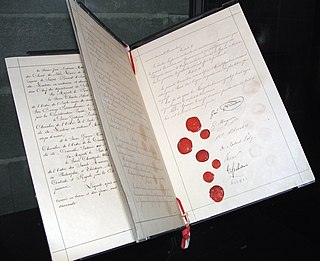Cultural property law is the body of law that protects and regulates the disposition of culturally significant material, [1] including historic real property, ancient and historic artifacts, artwork, and intangible cultural property. [2] Cultural property can be any property, tangible or intangible, having special significance to a defined group of people, whether or not the group is vested with a traditional property interest. [3] Cultural property laws may be international (such as international conventions or bilateral agreements) or domestic (such as federal laws or state laws).
Two major treaties have dealt with the issue of cultural heritage protection during armed conflict:
Repatriation issues may also apply domestically, for instance, in the United States, the 1990 Native American Graves Protection and Repatriation Act (NAGPRA) [5]

Cultural genocide or cultural cleansing is a concept which was proposed by lawyer Raphael Lemkin in 1944 as a component of genocide. Though the precise definition of cultural genocide remains contested, the Armenian Genocide Museum defines it as "acts and measures undertaken to destroy nations' or ethnic groups' culture through spiritual, national, and cultural destruction."

The Native American Graves Protection and Repatriation Act (NAGPRA), Pub. L. 101-601, 25 U.S.C. 3001 et seq., 104 Stat. 3048, is a United States federal law enacted on November 16, 1990.

The law of war is the component of international law that regulates the conditions for initiating war and the conduct of warring parties. Laws of war define sovereignty and nationhood, states and territories, occupation, and other critical terms of law.
The Treaty on the Protection of Artistic and Scientific Institutions and Historic Monuments or Roerich Pact is an inter-American treaty. The most important idea of the Roerich Pact is the legal recognition that the defense of cultural objects is more important than the use or destruction of that culture for military purposes, and the protection of culture always has precedence over any military necessity.

The Hague Convention for the Protection of Cultural Property in the Event of Armed Conflict is the first international treaty that focuses exclusively on the protection of cultural property in armed conflict. It was signed at The Hague, Netherlands, on 14 May 1954 and entered into force on 7 August 1956. As of September 2018, it has been ratified by 133 states.

Cultural heritage is the heritage of tangible and intangible heritage assets of a group or society that is inherited from past generations. Not all heritages of past generations are "heritage"; rather, heritage is a product of selection by society.
Traditional knowledge (TK), indigenous knowledge (IK) and local knowledge generally refer to knowledge systems embedded in the cultural traditions of regional, indigenous, or local communities. According to the World Intellectual Property Organization (WIPO) and the United Nations (UN), traditional knowledge and traditional cultural expressions (TCE) are both types of indigenous knowledge.
An intangible cultural heritage (ICH) is a practice, representation, expression, knowledge, or skill considered by UNESCO to be part of a place's cultural heritage. Buildings, historic places, monuments, and artifacts are cultural property. Intangible heritage consists of nonphysical intellectual wealth, such as folklore, customs, beliefs, traditions, knowledge, and language. Intangible cultural heritage is considered by member states of UNESCO in relation to the tangible World Heritage focusing on intangible aspects of culture. In 2001, UNESCO made a survey among States and NGOs to try to agree on a definition, and the Convention for the Safeguarding of the Intangible Cultural Heritage was drafted in 2003 for its protection and promotion.

Cultural heritage management (CHM) is the vocation and practice of managing cultural heritage. It is a branch of cultural resources management (CRM), although it also draws on the practices of cultural conservation, restoration, museology, archaeology, history and architecture. While the term cultural heritage is generally used in Europe, in the USA the term cultural resources is in more general use specifically referring to cultural heritage resources.

The Blue Shield, formerly the International Committee of the Blue Shield, is an international organization founded in 1996 to protect the world's cultural heritage from threats such as armed conflict and natural disasters. Originally intended as the "cultural equivalent of the Red Cross, its name derives from the blue shield symbol designed by Jan Zachwatowicz, used to signify cultural sites protected by the 1954 Hague Convention for the Protection of Cultural Property in Armed Conflict.
Protective signs are symbols to be used during an armed conflict to mark persons and objects under the protection of various treaties of international humanitarian law (IHL). While their essential meaning can be summarized as "Don't shoot" or "Don't attack", the exact conditions implied vary depending on the respective sign and the circumstances of its use. The form, shape and color of these signs are defined by the rules of IHL. Usually, they are easy to draw in order to make even an improvised use as easy as possible, and they were chosen to be as concise, recognizable and visible as possible under all circumstances.

The Intangible Cultural Heritage are aspects of intangible culture that the government of South Korea has officially designated for preservation in accordance with the 1962 Cultural Property Protection Law. They are proclaimed and maintained by South Korea's Cultural Heritage Administration.
The antiquities trade is the exchange of antiquities and archaeological artifacts from around the world. This trade may be illicit or completely legal. The legal antiquities trade abides by national regulations, allowing for extraction of artifacts for scientific study whilst maintaining archaeological and anthropological context. The illicit antiquities trade involves non-scientific extraction that ignores the archaeological and anthropological context from the artifacts.
The Rule of Law in Armed Conflicts Project is an initiative of the Geneva Academy of International Humanitarian Law and Human Rights to support the application and implementation of the international law of armed conflict.
The Intellectual Property Issues in Cultural Heritage (IPinCH) Project is a seven-year international research initiative based at Simon Fraser University, in British Columbia, Canada. IPinCH's work explores the rights, values, and responsibilities of material culture, cultural knowledge, and the practice of heritage research. The project is directed by Dr. George P. Nicholas, co-developed with Julie Hollowell and Kelly Bannister and is funded by the Social Sciences and Humanities Research Council of Canada's (SSHRC) major collaborative research initiatives (MCRI) program.

Common heritage of humanity is a principle of international law that holds the defined territorial areas and elements of humanity's common heritage should be held in trust for future generations and be protected from exploitation by individual nation states or corporations.

Cultural property comprises the physical items that are part of the cultural heritage of a group or society, as opposed to less tangible cultural expressions. They include such items as cultural landscapes, historic buildings, works of art, archaeological sites, as well as collections of libraries, archives and museums.

The values embodied in cultural heritage are identified in order to assess significance, prioritize resources, and inform conservation decision-making. It is recognised that values may compete and change over time, and that heritage may have different meanings for different stakeholders.
Art and culture law is the body of law, including domestic and foreign law, and multilateral treaties and conventions, that regulates and is applied to artists, fine art and cultural property. Art can expose society's faults and freedoms and often artistic expression can conflict with cultural and political ideals. Yet equally, art can also make sense of law - advancing dialogues on social injustice.
Military use of schools is a term used to refer to the various activities that national armed forces and non-state armed groups carry out in and around schools, universities, and other education facilities, in support of their military effort. Examples of this include using a school or a university as barracks or bases, for offensive or defensive deployments, for storage of weapons or ammunition, for military training of soldiers, as observation posts, and as a detention facility.
{{cite web}}: CS1 maint: archived copy as title (link)